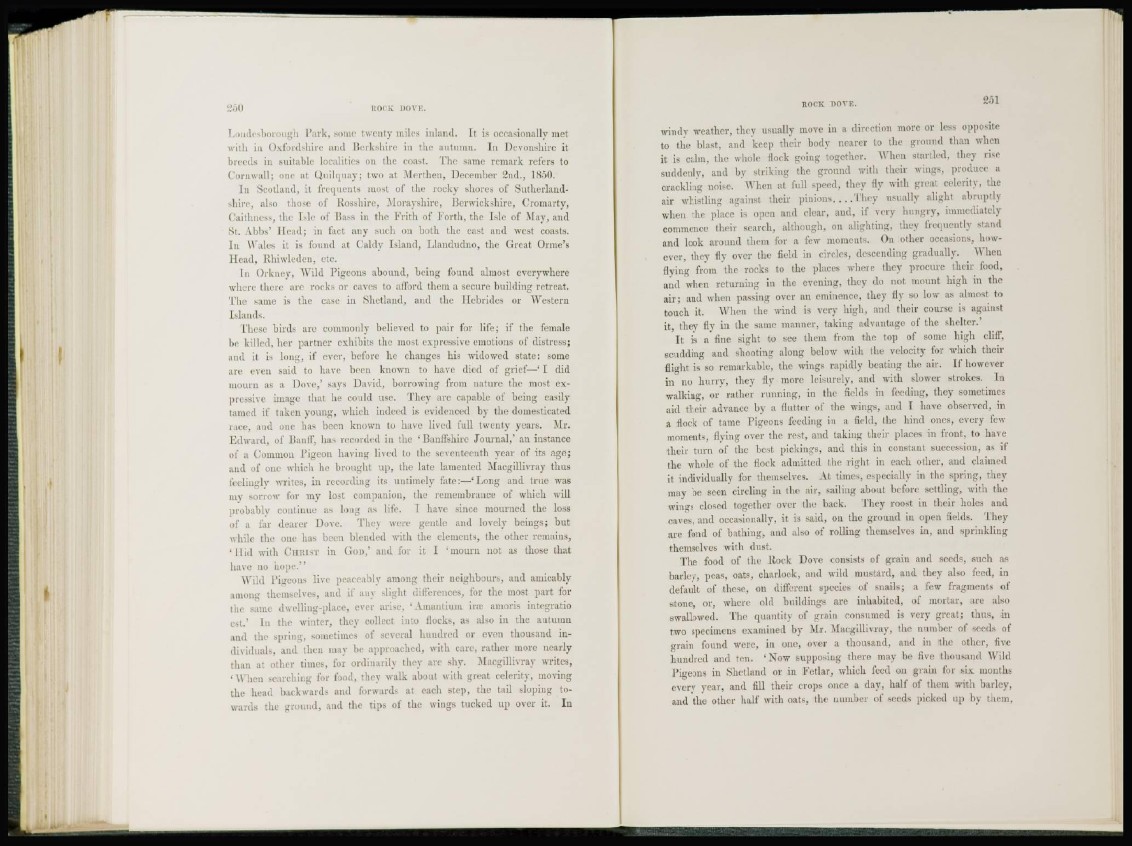
Londesborough Park, some twenty miles inland. It is occasionally met
with in Oxfordshire and Berkshire in the autumn. In Devonshire it
bree da in suitable localities on the coast. The same remark refers to
Cornwall; one at Quilquay; two at Mcrthen, December 2nd., 1850.
In Scotland, it frequents most of the rocky shores of Sutherlandshire,
also those of Kosshírc, Morayshire, Berwickshire, Cromarty,
Caithness, the Isle of Bass in the Frith of Forth, the Isle of .May, and
St. A b b s 1 Head; in fact any such on both the east and west coasts.
I n Wales it is found at Caldy Island, Llandudno, the Great Orme's
Head, lihiwlcden, etc.
In Orkney, Wild Fig-cons abound, being found almost everywhere
where there are rocks or caves to afford them a secure building retreat.
The same is the case in Shetland, and the Hebrides or Western
Islands.
[hese birds are commonly believed to pair for life; if the female
be killed, her partner exhibits the most expressive emotions of distress;
and it Is long, if ever, before he changes his widowed state: some
are even said to have been known to have died of grief—' I did
mourn as a Dove.1 says David, borrowing from nature the most expressive
image that he could use. They are capable of being easily
tamed if taken young, which indeed is evidenced by the domesticated
race, and one has been known to have lived full twenty years. Mr.
Edward, of Banff, has recorded in the * Banffshire Journal,' an instance
of a Common Pigeon having lived to the seventeenth year of its age;
and of one which he brought up, the late lamented Macgillivray thus
feelingly writes, in recording its untimely fate:—'Long and true was
my sorrow for my lost companion, the remembrance of which will
probably continue as long as life. I have since mourned the loss
of a far dearer Dove. They were gentle and lovely beings; but
while the one h a s been blended with t h e elements, the other remains,
' H i d with C h r i s t in Go d , ' and for it I •mourn not as those that
have no hope."
Wild Pigeons live peaceably among their neighbours, and amicably
among themselves, aud if any slight differences, for the most part for
the same dwelling-place, ever arise, 'Amantium irre amoris integratio
est.' In the winter, they collect into flocks, as also in the autumn
and the spring, sometimes of several hundred or even thousand individuals,
and then may be approached, with care, rather inore nearly
than at other times, for ordinarily they are shy. Macgillivray writes,
1 When searching for food, they walk about with great celerity, moving
the head backwards and forwards at each step, the tail sloping towards
the ground, and the tips of the wings tucked up over it. In
windy weather, they usually move in a direction more or less opposite
to the blast, and keep their body nearer to the ground than when
it is calm, the whole flock going together. When startled, they rise
suddenly, and by striking the ground with their wings, produce a
crackling noise. When at full speed, they fly with great celerity, the
air whistling against their pinions. . . .They usually alight abruptly
when the place is open and clear, aud, if very hungry, immediately
commence their search, although, on alighting, they frequently stand
and look around them for a few moments. On other occasions, however,
they fly over the field in circles, descending gradually. When
flying from the rocks to the places where they procure their food,
and when returning in the evening, they do not, mount high in the
a i r ; and when passing over an eminence, they fly so low as almost to
touch it. When the wind is very high, and their course is against
it, they fly in the same manner, taking advantage ( i f the shelter.'
It is a fine sight to see them from the top of some high cliff,
scudding and shooting along below with the velocity for which their
flight is so remarkable, the wings rapidly beating the air. If however
in no hurry, they fly more leisurely, and with slower strokes. In
walking, or rather running, in the fields in feeding, they sometimes
aid their advance by a flutter of the wings, and I have observed, in
a flock of tame Pigeons feeding in a field, the hind ones, every few
moments, flying over the rest, and taking their places in front, to have
their turn of the best pickings, and this in constant succession, as if
the whole of the flock admitted the right in each other, and claimed
ii individually for themselves. At times, especially in the spring, they
may be seen circling in the air, sailing about before settling, with the
wings closed together over the back. They roost in their holes and
caves, and occasionally, it is said, on the ground in open fields. They
are fond of bathing, and also of rolling themselves in, and sprinkling
themselves with dust.
The food of the Rock Dove consists of grain and seeds, such as
barley, peas, oats, charlock, and wild mustard, and they also feed, in
default of these, on different species of snails; a few fragments of
stone, or, where old buildings are inhabited, of mortar, aire also
swallowed. The quantity of grain consumed is very great; thus, in
two specimens examined by Mr. Macgillivray, the number of seeds of
grain found were, in one, over a thousand, and in the other, five
hundred and ten. ' Now supposing there may be five thousand Wild
Pigeons in Shetland or in Fetlar, which feed on grain tor six months
every year, and fill their crops once a day, half of them with barley,
and the other half with oats, the number of seeds picked up by them,